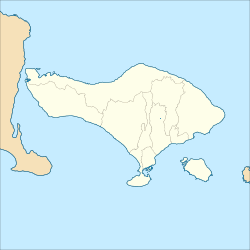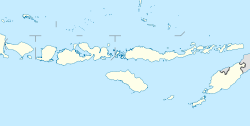Top Qs
Timeline
Chat
Perspective
Gianyar Regency
Regency in Bali, Indonesia From Wikipedia, the free encyclopedia
Remove ads
Gianyar Regency (Indonesian: Kabupaten Gianyar; Balinese: ᬓᬪᬹᬧᬢᬾᬦ᭄ᬕ᭄ᬬᬜᬃ, Kabupatén Gyañaŕ) is a regency (kabupaten) of the province of Bali, Indonesia. It has an area of 368.0 km2 and had a population 523.973 at mid of 2022 census. It is bordered by Badung Regency and Denpasar City to its west, Bangli Regency and Klungkung Regency to its east and the Badung Strait and the Indian Ocean to its south. Its regency seat is the town of Gianyar.
The town of Ubud, a centre of art and tourism, is located in Gianyar Regency.
Remove ads
History
Summarize
Perspective
The history of Gianyar Regency is determined by Regional Regulation of Gianyar Regency Number 9 of 2004 dated 2 April 2004 concerning the Anniversary of Gianyar Regency.
History 2.5 centuries more, precisely 252 years ago, 19 April 1771, when Gianyar was chosen as the name of a palace, Puri Agung, namely the King's Palace (Anak Agung) by Ida Dewa Manggis Sakti, then a sovereign and autonomous kingdom was born and participated in the power struggle of the kingdoms in Bali. In fact, the functioning of a palace, namely the Puri Agung Gianyar which has been determined by the conditions of the niskala scale which fell on April 19, 1771 is a historical milestone that has been built by the king (Ida Anak Agung) Gianyar I, Ida Dewata Manggis Sakti gave us the condition that the process of becoming and existing can be pulled back (previous period) or pulled forward (after period).
Kingdom period
Based on archaeological evidence in the Gianyar area, it is estimated that the emergence of human settlements in Gianyar occurred 2,000 years ago with the discovery of tool sites (artifacts) in the form of stones, bronze metal in the form of nekara (Bulan Pejeng), reliefs depicting the life of temples or caves on the cliffs of the Pakerisan river (tukad).
After written evidence was found in the form of inscriptions on stone or metal, the sites of the royal centers of the Warmadewa dynasty were identified at the Singamandawa Palace, Bedahulu. After the Gajah Mada (Majapahit) expedition was able to control the island of Bali, a Keraton Samprangan was built in the former headquarters of his troops as the center of government of the kingdom held by the Five Balinese Kings, namely:
- King Adipati Ida Dalem Krena Kepakisan (1350-1380), as the forerunner of the Kresna Kepakisan dynasty, then the Keraton Samprangan was able to survive for approximately three centuries.
- Ida Dalem Ketut Ngulesir (1380-1460)
- Ida Dalem Waturenggong (1460-1550)
- Ida Dalem Sagening (1580-1625)
- Ida Dalem Dimade (1625-1651).
The last two Balinese Kings, namely Ida Dalem Segening and Ida Dalem Dimade, have given rise to the forerunners of rulers in the regions. Ida Dewa Manggis Kuning (1600s) the ruler of Beng Village was the forerunner of the Manggis Dynasty which emerged after the second generation built the Payangan Kingdom (1735-1843). One of the sons of the king of Klungkung Ida Dewa Agung Jambe named Ida Dewa Agung Anom emerged as the forerunner of the dynasty of kings in Sukawati (1711-1771) including Peliatan and Ubud. In the same period, namely the Gelgel period, other regional rulers also emerged, namely I Gusti Ngurah Jelantik who controlled Blahbatuh and then I Gusti Agung Maruti who controlled the Keramas area, both of whom were descendants of Arya Kepakisan.
Colonialism period
The dynamics of the struggle between traditional elites from generation to generation have progressed at a certain momentum, one of which is the development of a palace city or royal city as the center of the kingdom's government called Gianyar. The development of a sovereign and fully autonomous royal city is Ida Dewa Manggis Sakti, the 4th generation of Ida Dewa Manggis Kuning.[citation needed]
Since the establishment of Puri Agung Gianyar on April 19, 1771, as well as the capital of the Gianyar Kingdom Government Center, it is a historical milestone. Since then and during the period afterward, the sovereign Gianyar Kingdom has also filled the pages of history of the kingdoms in Bali, consisting of nine kingdoms in Klungkung, Karangasem, Buleleng, Mengwi, Bangli, Payangan, Badung, Tabanan and Gianyar. However, until the end of the 19th century, after the collapse of Payangan and Mengwi on the one hand and the emergence of Jembrana on the other hand, the State): Klungkung, Karangasem, Bangli and Gianyar (ENI, 1917).
Early Independence Period
When the Dutch had taken control of the entire island of Bali, the 8 former kingdoms were still recognized by the Government of Guberneurmen but as part of the Dutch East Indies headed by a king (Selfbestuurder) in their respective swapraja regions. During the revolution, when the Bali region was included in the State of East Indonesia (NIT) autonomous regional kingdom (Swapraja) into an institution called Oka, the King of Gianyar was appointed as Chairman of the Council of Kings replacing the year 1947.[citation needed]
In addition, during the NIT period two other figures, namely Tjokorde Gde Raka Sukawati (Puri Kantor Ubud) became President of NIT and Ida A.A. Gde Agung (Puri Agung Gianyar) became Prime Minister of NIT, When the Republic of the United States of Indonesia (RIS) returned to the Unitary State (NKRI) on August 17 1950, then the regions throughout Indonesia were issued Law No. I of 1957, the implementation of which was regulated by Law No. 69 of 1958 which changed the Swatantra Region Level II (Daswati II). The name Daswati II applied uniformly throughout Indonesia until 1960. The first regent in DATI II Gianyar was Tjokorda Ngurah (1960-1963). The next regents were Drh. Tjokorda Anom Pudak (1963-1964) and Regent I Made Sayoga, BA (1964-1965). When Law No. 18 of 1965 was implemented, DATI II was changed to the name DATI II Regency. Then it was perfected by the issuance of Law No. 5 of 1974 which replaced the name of the Regency. The regional head is still called Regent.
Gianyar Regency Government Period
From the autonomy side, it is clear that the development process that occurred in Gianyar City. Autonomy and full sovereignty have been attached to the Kingdom Government since April 19, 1771, then processed until Regional Autonomy at Level II Regency which is in effect until now. [citation needed]
Various leadership styles and governing arts in the autonomy system have been partitioned on the pages of Gianyar City History. The process of autonomy dynamics is quite long since April 19, 1771 until April 19, 2023 today, since the palace city was built as the center of government of the autonomous kingdom to a district city, the name Gianyar is immortalized. Until now it has been 252 years old, the leaders of the city area, from the king (kingdom) to the Regent (Regency), have their own characteristics and styles and art of governing in the land of artists. Artists who are always down to earth in Gianyar and even worldwide.
Remove ads
Government and politics
Summarize
Perspective
The regent of Gianyar is the highest officeholder in the Gianyar Regency government. The Regent of Gianyar is responsible to the governor of the province of Bali. Currently, the regent or regional head serving in Gianyar Regency is I Made Agus Mahayastra, accompanied by the vice regent Anak Agung Gde Mayun who have served since 2018. Agus Mahayastra and Gde Mayun ran in the 2018 Gianyar regency election and 2024 Gianyar regency election.
Parliament

Administrative districts
The regency is divided into seven districts (kecamatan), tabulated below with their areas and population totals from the 2010 Census[5] and the 2020 Census,[6] together with the official estimates as at mid-2022.[1] The table also includes the number of administrative villages in each district (a total of 64 rural desa and 6 urban kelurahan), and its postal codes. The administrative centre of each district bears the same name as the district it is in.
Notes: (a) comprises 5 kelurahan and 12 desa. (b) including one kelurahan - the town of Ubud.
The four southern districts (Sukawati, Blahbatuh, Gianyar, and Ubud) are included within the official metropolitan area of Greater Denpasar (Sarbagita), while the three northern districts (Tampaksiring, Tegallalang, and Payangan) are excluded.
- Map of Gianyar Regency in Bali
- Map of districts in Gianyar Regency
List of districts and villages in Gianyar Regency as follows:
Remove ads
Demographics
Summarize
Perspective
Religion

The civil registry survey of April 2011 listed 480,447 people, of which 469,929 were classified as Hindu.[7]
Ethnic groups

Most of the ethnic groups in Gianyar are Balinese. Based on data from the Central Bureau of Statistics in the 2010 Indonesian Population Census, as many as 95.27% of the 496,777 inhabitants of Gianyar Regency are of the Balinese ethnic group.[8] Then the Javanese as much as 3.26%, and several others such as the Sasak , Sundanese, Madurese, and other ethnic groups.[8]
Here are population of Gianyar regency based on ethnicity in 2010:[8]
Tourism
Summarize
Perspective
Tourism is the main economic sector of Gianyar Regency, tourism is the mainstay of the economy of this regency.

Keramas Beach
Keramas Beach in Blahbatuh has hosted international surfing competitions in the last couple of years with limited facilities such as uneven roads and no parking lots. On June 18–29, 2013, Keramas Beach was on the Association of Surfing Professionals (ASP)'s 2013 Men's World Championship Tour schedule as the Oakley Bali Pro.[9][10]
Here are some of the tourist attractions in Gianyar Regency:
- Tegenungan Waterfall
- Bali Bird Park
- Bali Safari & Marine Park
- Taman Nusa–Indonesian Cultural Heritage Center
- Batuan Village
- Batubulan Village
- Celuk Village
- Mas Village
- Elephant Cave
- Gunung Kawi Temple
- Ubud Monkey Forest
- Sukawati Market
- Tampaksiring
- Ubud
- Guwang art market
- Sukawati traditional village art market
- Ketewel Beach
- Purnama Beach
- Lebih Beach
- Masceti Beach
- Saba Beach
- Keramas Beach
- Bali Zoo
- Bali Bird Park
- Payogan Agung Temple
- Museum of Antiquities
- Beji Guwang, Ketewel
- Kapten I Wayan Dipta Stadium
- Gianyar City Park
- Samuan Tiga Temple
- Ceking terraces
- Tirta Empul Temple
- Sebatu Temple
- Tampaksiring Palace
- Sukawati Market
- Kerobokan Cliff Temple
Remove ads
Sports


In football, Bali is home to the football club Bali United, which plays in the Super League, the top tier of the Indonesian football league. The team was relocated from Samarinda, East Kalimantan, to Gianyar, Bali. Harbiansyah Hanafiah, the main commissioner of Bali United, explained that he did the name change and moved the home to Bali because there were no representatives from Bali in the highest football tier in Indonesia.[11] Another reason was that local fans in Samarinda preferred to support Pusamania Borneo F.C. more than Persisam.
Remove ads
Geography
Climate
Gianyar has a tropical rainforest climate (Af) with moderate to heavy rainfall year-round. The following climate data is for the town of Gianyar.
Remove ads
Education
- Yayasan Slukat Learning Center (2007), a non-profit foundation and school located in the village of Keramas
Condotels and Apartments ban
Although Badung Regency, Denpasar City, and Gianyar Regency are the three richest regions in Bali and most of their wealth comes from tourism, in February 2012 Gianyar Regency officially banned the construction of new and increasingly popular condominium hotels ("condotels") and apartment facilities. Unlike the Badung Regency and Denpasar, where condotels and apartments remain in high demand for tourist developers and investors, Gianyar Regency wants to protect local entrepreneurs.[13]
Remove ads
Wildlife conservation


References
Further reading
External links
Wikiwand - on
Seamless Wikipedia browsing. On steroids.
Remove ads
















